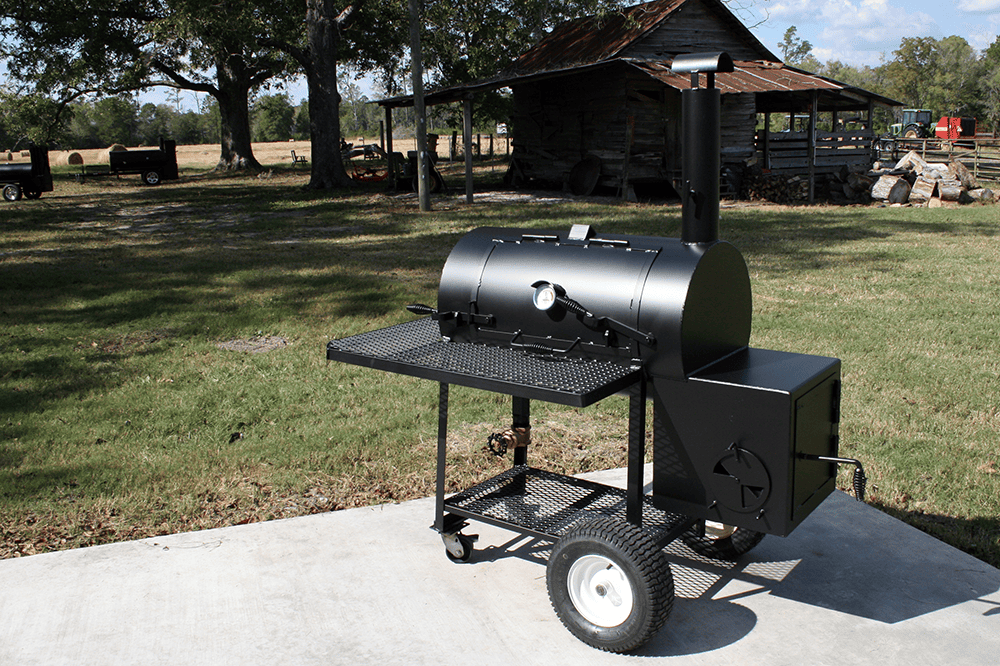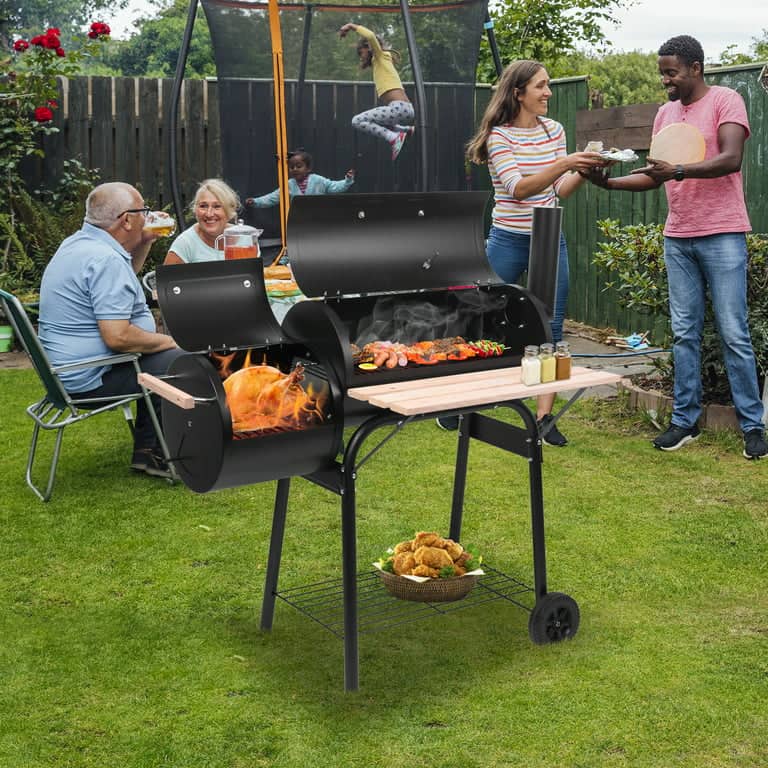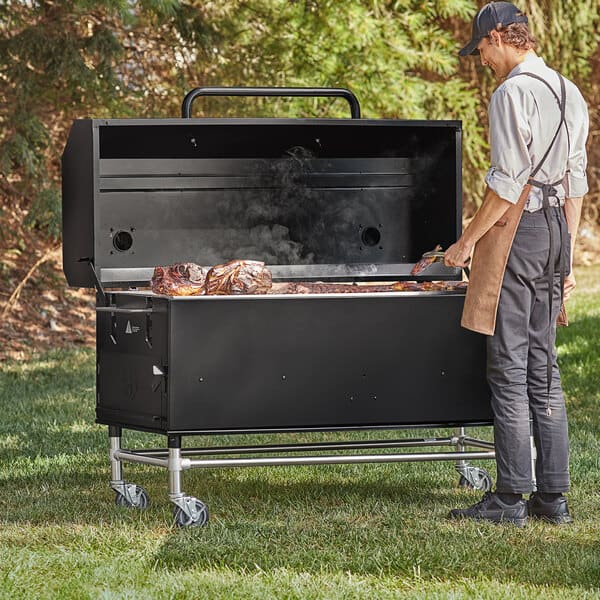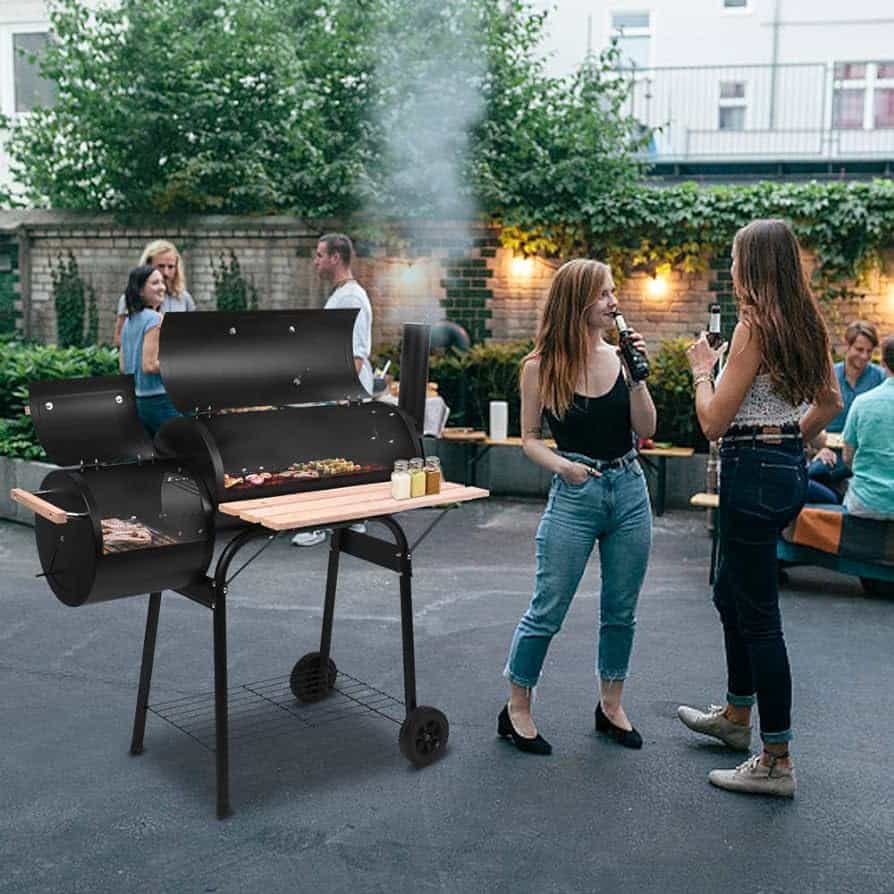Master the Art of Smoking: Tips and Tricks for Your Backyard Smoker
A backyard smoker is a cooking appliance designed for outdoor use that utilizes various fuel sources such as charcoal, wood, or propane to produce smoke for slow-cooking meats, vegetables, and other foods, typically used in home settings for leisurely outdoor cooking.
Smoking is a cooking method that has been used for centuries to infuse meat with delicious flavors and create tender, juicy results. It involves slow-cooking meat over low heat and smoke, which not only imparts a smoky flavor but also helps to break down tough connective tissues, resulting in tender and flavorful meat. Smoking is often associated with barbecue, but it can be used to cook a wide variety of meats, including chicken, pork, beef, and even fish.
One of the advantages of smoking over other cooking methods is the unique flavor it imparts to the meat. The combination of low heat and smoke creates a complex and rich flavor profile that is difficult to achieve with other cooking methods. Additionally, smoking allows for greater control over the cooking process, as the low heat ensures that the meat cooks slowly and evenly, resulting in tender and juicy results.
In recent years, smoking has gained popularity among home cooks. This can be attributed to several factors, including the rise of barbecue culture and the availability of affordable and user-friendly smokers. Many people are also drawn to the hands-on nature of smoking, as it allows them to connect with their food in a way that other cooking methods do not. Furthermore, smoking can be a social activity, as it often involves gathering friends and family around the smoker to enjoy the process and the end result.
Choosing the Right Smoker: Types and Features to Consider
When it comes to choosing a smoker, there are several options available on the market. The most common types of smokers include electric smokers, charcoal smokers, gas smokers, and pellet smokers. Each type has its own advantages and disadvantages, so it’s important to consider your specific needs and preferences before making a decision.
Electric smokers are popular among beginners because they are easy to use and require minimal effort. They are powered by electricity and have built-in temperature controls, making it easy to maintain a consistent temperature throughout the cooking process. However, electric smokers may not provide the same smoky flavor as other types of smokers.
Charcoal smokers are a favorite among purists because they offer a traditional smoking experience and produce a rich smoky flavor. They require more effort to use, as you need to manually control the temperature and add charcoal and wood chips as needed. However, many people find the extra effort to be worth it for the authentic flavor that charcoal smokers provide.
Gas smokers are another popular option, as they are convenient and easy to use. They are powered by propane gas and have built-in temperature controls, making it easy to maintain a consistent temperature. Gas smokers are also known for their quick heating times and efficient fuel consumption. However, some people find that gas smokers do not provide the same smoky flavor as other types of smokers.
Pellet smokers are a relatively new addition to the market but have gained popularity in recent years. They use wood pellets as fuel and have built-in temperature controls, making them easy to use. Pellet smokers offer the convenience of an electric smoker with the rich smoky flavor of a charcoal smoker. However, they can be more expensive than other types of smokers.
| Feature | Electric Smoker | Charcoal Smoker | Gas Smoker | Pellet Smoker |
|---|---|---|---|---|
| Fuel Source | Electricity | Charcoal | Propane | Wood Pellets |
| Temperature Control | Precise and easy to control | Variable, requires manual adjustment | Adjustable, may need frequent monitoring | Precise, often digitally controlled |
| Flavor Profile | Mild smoke flavor | Rich and traditional smoky flavor | Clean and adjustable smoke flavor | Versatile, with a range of wood flavors |
| Ease of Use | Very user-friendly | Requires more attention and monitoring | Easy to use, with quick heat-up times | User-friendly, automated temperature control |
| Temperature Range | Typically lower maximum temperature | Wide range, can achieve high temperatures | Adjustable, moderate temperature range | Wide range, suitable for various cooking styles |
| Startup Time | Quick | Longer, as charcoal needs to ignite | Quick, as propane heats up rapidly | Quick, as pellets ignite easily |
| Maintenance | Low maintenance | Requires more cleaning and ash removal | Moderate maintenance, propane tank monitoring | Moderate maintenance, pellet hopper management |
| Versatility | Limited in terms of traditional smoking | Versatile, suitable for smoking and grilling | Versatile, suitable for smoking and grilling | Versatile, suitable for smoking, grilling, baking, and more |
| Cost | Generally affordable | Moderate cost, depends on the model | Moderate cost, propane refills add to expenses | Typically higher initial cost, but varies |
| Portability | Portable, easy to move | May be less portable due to charcoal handling | Portable, but propane tank adds weight | Portable, but pellet hopper adds weight |
When choosing a smoker, there are several factors to consider. Size is an important consideration, as you want to make sure that your smoker can accommodate the amount of food you plan to cook. Portability is another factor to consider if you plan on taking your smoker on camping trips or tailgating events. Ease of use is also important, especially if you are a beginner or prefer a hassle-free cooking experience.
In addition to these factors, there are several features to look for in a smoker. Temperature control is crucial for maintaining a consistent cooking temperature throughout the smoking process. Insulation is also important, as it helps to retain heat and ensure even cooking. Other features to consider include a built-in thermometer, a removable ash pan for easy cleaning, and sturdy construction for durability.
Preparing Your Meat: Brining, Rubs, and Marinades
Before smoking your meat, it’s important to properly prepare it to enhance its flavor and tenderness. There are several methods of preparing meat for smoking, including brining, dry rubs, and marinades.
Brining involves soaking the meat in a solution of salt and water for a period of time before smoking. This helps to tenderize the meat and infuse it with flavor. The salt in the brine helps to break down the proteins in the meat, resulting in a more tender and juicy end result. Brining is particularly effective for lean cuts of meat, such as chicken breasts or pork loin, which can easily dry out during the smoking process.
Dry rubs are another popular method of preparing meat for smoking. A dry rub is a mixture of herbs, spices, and other seasonings that is applied directly to the surface of the meat. The rub forms a flavorful crust on the meat as it cooks, adding depth and complexity to the final dish. Dry rubs can be customized to suit your taste preferences and can be as simple or as complex as you like.
Marinades are another option for preparing meat before smoking. A marinade is a mixture of liquids, such as vinegar, oil, or citrus juice, along with herbs, spices, and other flavorings. The meat is soaked in the marinade for a period of time before smoking, allowing it to absorb the flavors. Marinades not only add flavor to the meat but also help to tenderize it by breaking down tough connective tissues.
When choosing a seasoning for your meat, it’s important to consider the type of meat you are cooking and your personal taste preferences. Some seasonings pair better with certain types of meat than others. For example, a sweet and smoky rub may work well with pork ribs, while a spicy rub may be better suited for beef brisket. It’s also important to consider the cooking time and temperature, as some seasonings may burn or become bitter if exposed to high heat for too long.
Lighting the Fire: Charcoal, Wood, and Other Fuel Options
The fuel you choose for your smoker can have a significant impact on the flavor of your smoked meat. There are several options available, including charcoal, wood, and other fuel options.
Charcoal is a popular choice for smoking because it produces a rich smoky flavor. It burns at a high temperature and provides a consistent heat source throughout the cooking process. Charcoal briquettes are readily available and easy to use, making them a convenient option for beginners. Lump charcoal, which is made from natural hardwood, is another option that provides a more intense smoky flavor.
Wood is another popular fuel option for smoking. Different types of wood produce different flavors, so it’s important to choose the right wood for the type of meat you are cooking. Some common types of smoking woods include hickory, mesquite, applewood, cherrywood, and oak.
Hickory is known for its strong and smoky flavor and pairs well with beef and pork. Mesquite has a bold and intense flavor that works well with beef and game meats. Applewood and cherrywood have a sweet and fruity flavor that pairs well with poultry and pork. Oak has a mild flavor that works well with all types of meat.
How to Make Wood Pellets? An Easy Guide for DIY Enthusiasts
In addition to charcoal and wood, there are other fuel options available for smokers. Propane gas is a convenient option that provides consistent heat and allows for easy temperature control. Pellets made from compressed sawdust are another option that provides a clean and efficient burn. Electric smokers use electricity as a fuel source and are easy to use but may not provide the same smoky flavor as other fuel options.
When lighting the fire in your smoker, it’s important to follow the manufacturer’s instructions and take safety precautions. Make sure to use a chimney starter or electric starter to light the charcoal, as using lighter fluid can impart a chemical taste to the meat. If using wood chips or chunks, soak them in water for at least 30 minutes before adding them to the fire. This will help to produce more smoke and prevent them from burning too quickly.
Controlling the Temperature: Thermometers and Airflow
Temperature control is crucial for successful smoking, as it ensures that the meat cooks evenly and reaches the desired level of doneness. There are several factors that can affect the temperature in your smoker, including the type of smoker you are using, the fuel you are using, and the weather conditions.
One of the most important tools for temperature control in smoking is a thermometer. There are several types of thermometers available, including instant-read thermometers, probe thermometers, and wireless thermometers. Instant-read thermometers are used to quickly check the internal temperature of the meat. Probe thermometers are inserted into the meat and provide a continuous reading of the internal temperature. Wireless thermometers allow you to monitor the temperature of your smoker and the internal temperature of the meat from a distance.
In addition to using a thermometer, controlling airflow in your smoker is also important for temperature control. Most smokers have vents or dampers that can be adjusted to regulate airflow. Opening the vents allows more oxygen into the smoker, which increases the heat. Closing the vents restricts airflow and lowers the heat. It’s important to monitor the temperature closely and make adjustments as needed throughout the smoking process.
Smoking Woods: Types and Pairings with Different Meats
The type of wood you use for smoking can have a significant impact on the flavor of your smoked meat. Different types of wood produce different flavors, so it’s important to choose the right wood for the type of meat you are cooking.
Hickory is one of the most popular smoking woods and is known for its strong and smoky flavor. It pairs well with beef and pork and is often used for smoking ribs, brisket, and pulled pork. Mesquite is another popular smoking wood that has a bold and intense flavor. It works well with beef and game meats and is often used for smoking steaks, burgers, and venison.
Applewood and cherrywood have a sweet and fruity flavor that pairs well with poultry and pork. Applewood is often used for smoking chicken, turkey, and pork chops, while cherrywood is popular for smoking ham and bacon. Oak is a versatile smoking wood that has a mild flavor that works well with all types of meat. It is often used for smoking ribs, brisket, and sausages.
| Smoking Wood Type | Flavor Profile | Recommended Meats |
|---|---|---|
| Apple | Mild, fruity | Chicken, Turkey, Pork, Fish, Vegetables |
| Cherry | Sweet, mild | Chicken, Turkey, Pork, Beef, Lamb, Duck |
| Hickory | Strong, bacon-like | Pork (especially ribs), Beef, Game Meats |
| Mesquite | Strong, earthy | Beef, Lamb, Game Meats, Poultry (sparingly) |
| Pecan | Sweet, nutty | Chicken, Turkey, Pork, Beef, Lamb |
| Oak | Medium, versatile | Beef, Lamb, Game Meats, Pork, Poultry |
| Alder | Mild, slightly sweet | Fish, Seafood, Poultry, Pork |
| Maple | Mild, slightly sweet | Pork, Poultry, Vegetables |
| Peach | Mild, fruity | Pork, Chicken, Turkey, Fish |
When using smoking woods, it’s important to use them in moderation to avoid overpowering the flavor of the meat. Too much smoke can result in a bitter or acrid taste. It’s also important to choose hardwoods that are free from chemicals or additives, as these can affect the flavor of the meat.
To use smoking woods, soak them in water for at least 30 minutes before adding them to the fire. This will help to produce more smoke and prevent them from burning too quickly. You can also wrap the wood chips or chunks in aluminum foil to create a smoke packet, which will slow down the burning process and produce more smoke.
Maintenance and Cleaning: Keeping Your Smoker in Top Condition
Proper maintenance and cleaning are important for keeping your smoker in top condition and ensuring that it performs optimally. Regular maintenance will help to extend the lifespan of your smoker and prevent issues from arising.
One of the most important aspects of smoker maintenance is cleaning. After each use, it’s important to clean the grates, drip pans, and other surfaces to remove any leftover food particles and grease. This can be done using a grill brush or scraper and warm soapy water. It’s also important to clean the inside of the smoker to remove any built-up residue or ash. This can be done using a vacuum or a brush specifically designed for cleaning smokers.
In addition to regular cleaning, it’s important to inspect your smoker for any signs of wear or damage. Check the seals and gaskets for any cracks or leaks, as these can affect the temperature control and cooking performance of the smoker. Replace any damaged parts as needed to ensure that your smoker continues to function properly.
Another important aspect of smoker maintenance is seasoning. Seasoning involves coating the inside of the smoker with oil to create a protective layer that prevents rust and helps to maintain heat retention. To season your smoker, simply coat the inside surfaces with a thin layer of cooking oil and heat it at a high temperature for about an hour. This will help to create a non-stick surface and prevent food from sticking to the grates.
It’s also important to store your smoker properly when not in use. If possible, cover it with a waterproof cover to protect it from the elements. Store it in a dry and well-ventilated area to prevent rust and mold from forming.
Timing and Planning: Scheduling Your Smoking Session
Timing and planning are crucial for successful smoking, as different types of meat require different cooking times and preparation methods. It’s important to plan ahead and allow enough time for the meat to cook properly.
One of the first things to consider when planning a smoking session is the type of meat you will be cooking. Different types of meat require different cooking times and temperatures. For example, chicken typically cooks faster than pork or beef, so you will need to adjust your cooking time accordingly.
It’s also important to consider the size and thickness of the meat. Thicker cuts of meat will take longer to cook than thinner cuts. It’s a good idea to use a probe thermometer to monitor the internal temperature of the meat and ensure that it reaches the desired level of doneness.
Another factor to consider when planning a smoking session is the weather conditions. Wind, rain, and extreme temperatures can affect the cooking time and temperature in your smoker. It’s important to monitor the temperature closely and make adjustments as needed throughout the smoking process.
When planning a smoking session, it’s a good idea to allow some extra time for unexpected delays or issues that may arise. Smoking is a slow and gradual cooking process, so it’s important to be patient and allow enough time for the meat to cook properly.
Tips for Perfect Results: Resting, Slicing, and Serving Your Meat
After smoking your meat, it’s important to allow it to rest before slicing and serving. Resting allows the juices to redistribute throughout the meat, resulting in a more tender and flavorful end result.
To rest your meat, simply remove it from the smoker and let it sit on a cutting board or platter for about 10-15 minutes. This will allow the internal temperature to stabilize and the juices to settle. It’s important to cover the meat loosely with foil or a clean kitchen towel to keep it warm during the resting period.
Once the meat has rested, it’s time to slice and serve. The way you slice your meat can have a significant impact on its texture and presentation. It is important to use a sharp knife to ensure clean and even slices.
For larger cuts of meat, such as roasts or steaks, it is best to slice against the grain. This means cutting perpendicular to the direction of the muscle fibers. Slicing against the grain helps to break up the muscle fibers, resulting in a more tender and easier-to-chew piece of meat.
Additionally, slicing the meat thinly can enhance its tenderness and make it easier to eat. Finally, arranging the slices neatly on a platter or individual plates can enhance the overall presentation of the dish.
Originally posted 2024-02-01 02:28:25.





